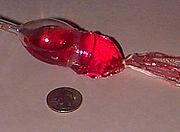
Dialysis tubing
Encyclopedia

Semipermeable membrane
A semipermeable membrane, also termed a selectively permeable membrane, a partially permeable membrane or a differentially permeable membrane, is a membrane that will allow certain molecules or ions to pass through it by diffusion and occasionally specialized "facilitated diffusion".The rate of...
tubing
Tubing
Tubing may refer to:* Tubing , flexible hose or pipe * Tubing , the act of riding an inner tube* Structural tubing* Plumbing tube used in domestic water systems* Inserting a tube* Brass instrument tubing...
made from regenerated cellulose
Cellulose
Cellulose is an organic compound with the formula , a polysaccharide consisting of a linear chain of several hundred to over ten thousand β linked D-glucose units....
or cellophane
Cellophane
Cellophane is a thin, transparent sheet made of regenerated cellulose. Its low permeability to air, oils, greases, bacteria and water makes it useful for food packaging...
. It can be used for diffusion
Diffusion
Molecular diffusion, often called simply diffusion, is the thermal motion of all particles at temperatures above absolute zero. The rate of this movement is a function of temperature, viscosity of the fluid and the size of the particles...
with solutes or osmosis
Osmosis
Osmosis is the movement of solvent molecules through a selectively permeable membrane into a region of higher solute concentration, aiming to equalize the solute concentrations on the two sides...
if used with water only. Osmosis is when water passes through a semi-permeable layer to reach equilibrium. Diffusion, on the other hand, allows the movement of molecules from high concentration to low concentration. It will only allow molecules to pass through a semi-permeable membrane or layer if the molecule is small enough to fit through the membrane or a membrane's pore. This usually results with the effects of diffusion through a membrane only really affects small molecules, and almost never larger molecules. Dialysis tubing is used in clinical circumstances to ensure a filtered flow of molecules, preventing the flow of larger solute molecules. Small molecules can be "washed" out of a solution which is pumped through the tubing into a solvent, usually water
Water
Water is a chemical substance with the chemical formula H2O. A water molecule contains one oxygen and two hydrogen atoms connected by covalent bonds. Water is a liquid at ambient conditions, but it often co-exists on Earth with its solid state, ice, and gaseous state . Water also exists in a...
, which surrounds it and in which they can be flushed away.
Dialysis tubing is permeable to glucose, but not to any starches or proteins. This is because the polymeric protein and starch molecules are too large to pass through the semi-permeable dialysis tubing. This process mimics the function of a semi-permeable cell membrane, which selectively through passive transportation or active transportation allows some molecules to pass through the membrane.
In demonstrations of semi-permeable membranes, a solution containing several types of molecules, usually glucose
Glucose
Glucose is a simple sugar and an important carbohydrate in biology. Cells use it as the primary source of energy and a metabolic intermediate...
and starch
Starch
Starch or amylum is a carbohydrate consisting of a large number of glucose units joined together by glycosidic bonds. This polysaccharide is produced by all green plants as an energy store...
, is placed into a semi-permeable dialysis
Dialysis
In medicine, dialysis is a process for removing waste and excess water from the blood, and is primarily used to provide an artificial replacement for lost kidney function in people with renal failure...
bag, such as a cellulose
Cellulose
Cellulose is an organic compound with the formula , a polysaccharide consisting of a linear chain of several hundred to over ten thousand β linked D-glucose units....
membrane with pores, and the bag is sealed with a knot or elastic band. The sealed dialysis bag is placed in a container of a different solution, or water. Molecules small enough to pass through the tubing (water, salts, monosaccharides, and other small molecules) tend to move into or out of the dialysis bag in the direction of decreasing concentration, therefore displaying diffusion. Larger molecules (such as protein
Protein
Proteins are biochemical compounds consisting of one or more polypeptides typically folded into a globular or fibrous form, facilitating a biological function. A polypeptide is a single linear polymer chain of amino acids bonded together by peptide bonds between the carboxyl and amino groups of...
s, or polysaccharide
Polysaccharide
Polysaccharides are long carbohydrate molecules, of repeated monomer units joined together by glycosidic bonds. They range in structure from linear to highly branched. Polysaccharides are often quite heterogeneous, containing slight modifications of the repeating unit. Depending on the structure,...
s) that have dimensions significantly greater than the pore diameter are retained inside the dialysis bag. The water and smaller solutes in a hypotonic solution (a solution that has a lesser solute concentration than the solution it is referenced to) will cross a semi-permeable membrane, like dialysis tubing, into a hypertonic solution (a solution that has a higher solute concentration than the solution it is referenced to) in an attempt to reach equilibrium, where the solute concentration of each solution is in equilibrium.

